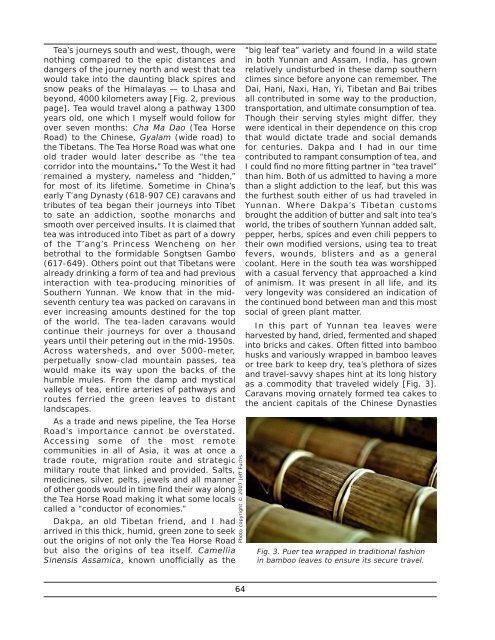The Silk Road
You also want an ePaper? Increase the reach of your titles
YUMPU automatically turns print PDFs into web optimized ePapers that Google loves.
Tea’s journeys south and west, though, were<br />
nothing compared to the epic distances and<br />
dangers of the journey north and west that tea<br />
would take into the daunting black spires and<br />
snow peaks of the Himalayas — to Lhasa and<br />
beyond, 4000 kilometers away [Fig. 2, previous<br />
page]. Tea would travel along a pathway 1300<br />
years old, one which I myself would follow for<br />
over seven months: Cha Ma Dao (Tea Horse<br />
<strong>Road</strong>) to the Chinese, Gyalam (wide road) to<br />
the Tibetans. <strong>The</strong> Tea Horse <strong>Road</strong> was what one<br />
old trader would later describe as “the tea<br />
corridor into the mountains.” To the West it had<br />
remained a mystery, nameless and “hidden,”<br />
for most of its lifetime. Sometime in China’s<br />
early T’ang Dynasty (618-907 CE) caravans and<br />
tributes of tea began their journeys into Tibet<br />
to sate an addiction, soothe monarchs and<br />
smooth over perceived insults. It is claimed that<br />
tea was introduced into Tibet as part of a dowry<br />
of the T’ang’s Princess Wencheng on her<br />
betrothal to the formidable Songtsen Gambo<br />
(617-649). Others point out that Tibetans were<br />
already drinking a form of tea and had previous<br />
interaction with tea-producing minorities of<br />
Southern Yunnan. We know that in the midseventh<br />
century tea was packed on caravans in<br />
ever increasing amounts destined for the top<br />
of the world. <strong>The</strong> tea-laden caravans would<br />
continue their journeys for over a thousand<br />
years until their petering out in the mid-1950s.<br />
Across watersheds, and over 5000-meter,<br />
perpetually snow-clad mountain passes, tea<br />
would make its way upon the backs of the<br />
humble mules. From the damp and mystical<br />
valleys of tea, entire arteries of pathways and<br />
routes ferried the green leaves to distant<br />
landscapes.<br />
As a trade and news pipeline, the Tea Horse<br />
<strong>Road</strong>’s importance cannot be overstated.<br />
Accessing some of the most remote<br />
communities in all of Asia, it was at once a<br />
trade route, migration route and strategic<br />
military route that linked and provided. Salts,<br />
medicines, silver, pelts, jewels and all manner<br />
of other goods would in time find their way along<br />
the Tea Horse <strong>Road</strong> making it what some locals<br />
called a “conductor of economies.”<br />
Dakpa, an old Tibetan friend, and I had<br />
arrived in this thick, humid, green zone to seek<br />
out the origins of not only the Tea Horse <strong>Road</strong><br />
but also the origins of tea itself. Camellia<br />
Sinensis Assamica, known unofficially as the<br />
Photo copyright © 2007 Jeff Fuchs<br />
“big leaf tea” variety and found in a wild state<br />
in both Yunnan and Assam, India, has grown<br />
relatively undisturbed in these damp southern<br />
climes since before anyone can remember. <strong>The</strong><br />
Dai, Hani, Naxi, Han, Yi, Tibetan and Bai tribes<br />
all contributed in some way to the production,<br />
transportation, and ultimate consumption of tea.<br />
Though their serving styles might differ, they<br />
were identical in their dependence on this crop<br />
that would dictate trade and social demands<br />
for centuries. Dakpa and I had in our time<br />
contributed to rampant consumption of tea, and<br />
I could find no more fitting partner in “tea travel”<br />
than him. Both of us admitted to having a more<br />
than a slight addiction to the leaf, but this was<br />
the furthest south either of us had traveled in<br />
Yunnan. Where Dakpa’s Tibetan customs<br />
brought the addition of butter and salt into tea’s<br />
world, the tribes of southern Yunnan added salt,<br />
pepper, herbs, spices and even chili peppers to<br />
their own modified versions, using tea to treat<br />
fevers, wounds, blisters and as a general<br />
coolant. Here in the south tea was worshipped<br />
with a casual fervency that approached a kind<br />
of animism. It was present in all life, and its<br />
very longevity was considered an indication of<br />
the continued bond between man and this most<br />
social of green plant matter.<br />
In this part of Yunnan tea leaves were<br />
harvested by hand, dried, fermented and shaped<br />
into bricks and cakes. Often fitted into bamboo<br />
husks and variously wrapped in bamboo leaves<br />
or tree bark to keep dry, tea’s plethora of sizes<br />
and travel-savvy shapes hint at its long history<br />
as a commodity that traveled widely [Fig. 3].<br />
Caravans moving ornately formed tea cakes to<br />
the ancient capitals of the Chinese Dynasties<br />
Fig. 3. Puer tea wrapped in traditional fashion<br />
in bamboo leaves to ensure its secure travel.<br />
64

















